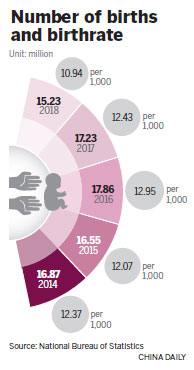Baby numbers in sharp decline
Age a key factor as first-time mothers get older and desire for second child fades
Chen Yan, a primary school teacher, is a proud and happy mother of two children from Liaocheng city, Shandong province. She decided to become pregnant with her youngest child following the implementation of the second-child policy in January 2016 and gave birth to a baby boy later that year.
"A lot of women of my age had a second child, and did so within a certain period of time soon after the one-child birth limit was lifted," she said.
But there was a sharp drop in births in the city over the last year.

The city saw a 26 percent year-on-year decrease in newborns from January to November - with 23,179 fewer babies born - and the number of children born to families that already had a child dropped by nearly 36 percent, the city's health commission said.
Such a fall in the birthrate lends credence to projections of a substantial drop decline across the country.
A total of 15.23 million babies were born last year on the Chinese mainland, about 2 million less than in 2017, according to data released by the National Bureau of Statistics on Monday.
It marks the third consecutive year of a decrease since the country relaxed its family planning policy and fully implemented the universal second-child policy.
The birth rate also dropped from 1,243 to 1,094 per 100,000 of the population from 2017 to 2018, NBS figures show.
Before the data was released on Monday, population experts in China predicted the number of births for last year would continue to fall due to various factors, such as a rapid decrease in the number of women of childbearing age and mothers of one child thinking twice about having another.
Shandong is seen by experts as key due to its comprehensive implementation of national family planning agendas.
Another city in the province has also seen a sharp decline. The coastal city of Qingdao recorded a year-on-year fall of about 20 percent in newborns from January to November, and the number of second children fell by 29 percent, the municipal government said on Dec 18.
Other major cities in Shandong with populations of more than 5 million also reported declines in births - ranging from 16 to 22 percent - in the first half of 2018.
"The number of births in the province in 2018 is expected to have fallen by 15 to 20 percent, and births of second children also declined," said Cui Shuyi, head of the population research institute at the Shandong Academy of Social Sciences.
Shandong initially saw a surge in the province's new arrivals in 2016 and 2017, following the second-child policy, accounting for more than 10 percent of China's total.
More than 63 percent of the babies born in Shandong in 2016 were second children, with the percentage rising to almost 67 percent in 2017, according to the provincial health authority, while the national ratio hovered around 50 percent.
Cui said the trend of second births being in a majority in Shandong will also vanish, given that most women who planned to have a second child did so already soon after the new policy was implemented.
The widespread decrease in births across Shandong has renewed concerns about a substantial drop in the country's total births last year.
Tao Tao, a population researcher at Renmin University of China in Beijing, said a shrinking pool of women of childbearing age has contributed to the declining birthrate.
She also pointed out that the average ages of women bearing their first and second child have both risen by a year over the past three years, which affected their fertility.
"Our research also points to common concerns, especially housing, employment, protection of female workers, taxation and more," she said.
"We need more policies supportive of fertility and help families tackle difficulties arising in the process of giving births and raising children," she said.
Wang Xiaodong contributed to this story.
Contact the writers at wangxiaoyu@chinadaily.com.cn
(China Daily 01/22/2019 page3)














